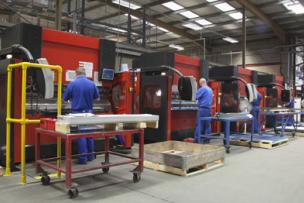Cutting or delaying capital expenditures may generally be the first move some companies make when facing a liquidity crisis, but it’s important to stay as strategic as possible, Ellison said. The idea is to save on costs in a way that will help you grow, help you differentiate your business, and help you stay ahead of your competitors.
Cost-Saving Techniques
Many manufacturers are likely facing challenges in light of the pandemic, but they also likely recognize that the current crisis is a unique opportunity to pursue actions that will maximize their chances of long-term success.
From investing in preventive and corrective maintenance of machines to identifying waste and bottlenecks within your operations, there are many opportunities to maximize a shop’s efficiency.
Manufacturing companies looking to do more with less may rely on quick cost reductions to get by, but this kind of approach may only mean small savings in the short term. Looking for ways to improve productivity is a more powerful approach, says Brandon Hull, Guhring’s director of product management and business development.
One of the most expensive resources in a manufacturing facility is machine time, Hull says. Making a tool last just as long as the previous tool, but cutting the cycle time in half, will help you save more money in the long run than simply purchasing cheaper tools to save money, he says, adding that cutting cycle time will, of course, require some research.
Read more: Looking for cost savings and productivity improvements? Try our productivity calculator.
Indeed, continuing to use a tool that has reached the end of its life can cost you more by leading to more substandard parts or sudden machining errors, which can lead to expensive downtime or revisions. Either repair these tools immediately or discard them, replacing them with newer tools that will ultimately make you more productive. With this in mind, it’s worth inspecting your equipment periodically and taking the time to thoroughly clean it between operations.
Long setup times are a drain on productivity, too. These periods—including teardowns and the loading of parts and tools—add no value to your operations and should be as short as possible. You can shorten them with techniques such as the smart organization of tools near your equipment, or pre-planning machine setups. You may also invest in toolpath simulation software, standardized toolsets or offline presetting.
The more reliable your equipment is, the more uptime you’ll get. Unreliable or outdated equipment that lets you down when you’re trying to finish an important job should be avoided. Having equipment that can tell you when it’s going to fail or needs attention can minimize your downtime and maximize your productive output and capacity to meet customer demands.
Continuous monitoring of machine health can help you achieve this. For example, the technology that monitors a spindle for abnormalities in real time using sensors can reduce scrap and improve productivity, helping shops prevent damage to machines. Reliable, real-time data and analytics mean you can take risks without undue side effects and avoid a costly shutdown.
Read more: Managing Downtime: A Guide to Improving Shop Productivity During Manufacturing Slowdowns
Manufacturers who want to make an initial foray into the world of automation may consider cost-effective applications that can solve common issues that lead to unnecessary costs and inefficiencies. These applications may include machine vision systems for measuring, inspecting and organizing parts and components, feeders for sorting components on an assembly line, or even collaborative robots (cobots) that are designed to work alongside humans to help them complete tasks on the shop floor.
Now is a perfect time to invest in your company’s evolution. And as manufacturing companies improve their tooling, they’ll also want to update their workers’ skills. Your employees will need access to education and regular training sessions to keep up with the industry’s needs and to ensure they have the most advanced skills.
Looking for Growth Drivers
As the crisis plays out, manufacturers may want to look more deeply at their business operations. Redirecting funds to the right growth drivers, for example, can build the strength needed to weather the storm and emerge from the crisis stronger.
As consulting company PwC noted in a recent report, achieving this balance begins with answering some simple questions:
- How has your market changed? What’s happened to your customers, suppliers and competitors? What market trends or disruptors have accelerated?
- What value propositions look promising in a post-COVID-19 world?
- Can you articulate the few things your organization needs to do better than anyone else to meet those value propositions? What will your competitive advantage be?
- Are you investing enough in those few things? Where do you need to spend less so you have the funds to redirect costs to value-creating differentiation?
The strengths that distinguished your company before the pandemic may not be the ones that work in the post-crisis world, PwC notes.
To determine your strengths in a new environment, ask yourself the questions above to “quickly frame your few must-haves,” the report advises. “Doubling down in these areas helps ensure that no matter what the outcome, your business has the right muscles to emerge stronger.”
What tips can you share about reducing costs? What are your best practices? Share your insights in the comments below.





Talk to Us!
Thanks!
33Leave a reply
Your email address will not be published. Required fields are marked *